Abstract
Nanolenses are gaining importance in nanotechnology, but their challenging fabrication is thwarting their wider adoption. Of particular challenge is facile control of the lens’ curvature. In this work, we demonstrate a new nanoimprinting technique capable of realizing polymeric nanolenses in which the nanolens’ curvature is optically controlled by the ultraviolet (UV) dose at the pre-curing step. Our results reveal a regime in which the nanolens’ height changes linearly with the UV dose. Computational modeling further uncovers that the polymer undergoes highly nonlinear dynamics during the UV-controlled nanoimprinting process. Both the technique and the process model will greatly advance nanoscale science and manufacturing technology.
1. Introduction
Nanoscale lenses, or nanolenses, are attracting intense research interests for their crucial roles in many fields of optics, including super-resolution imaging [1], extraordinary focusing [2], and highly efficient light harvesting and emission [3]. Recently, they have even been utilized for quantum optics [4]. Accordingly, multiple techniques have been developed for their facile realization. They include chemical growth [1,5], self-organized dewetting [6], and thermal reflow [7], just to name a few.
In most existing fabrication techniques, the in-plane characteristics of the nanolens, such as the diameter, lattice pattern, and pitch, can be precisely controlled during the initial patterning steps. They, often fall short, however, in accurate control of the “out-of-plane” characteristics of the nanolens. The most notable examples are the curvature and the height which critically govern the optical functionalities of the nanolens.
So far, control of the nanolens’ curvature or height has been accomplished by techniques such as thermal reshaping [7], adjustment of the liquid’s surface tension and volume [8], or solvent exchange [9]. They, often necessitate complex additional processes, however. Moreover, in some of them, the in-plane and out-of-plane characteristics are coupled, leading the change in in-plane characteristics (lens diameter, for example) to affect out-of-plane characteristics (lens curvature, for example) or vice versa, further complicating the realization of the nanolens.
Here, we demonstrate a new technique for the curvature-adjustable realization of polymeric nanolenses. Unlike the conventional nanoimprint lithography techniques which critically rely on the initial patterning [10,11,12,13], our new technique is based on the newly reported peculiarities in photopolymer’s interaction with elastomeric nanocavities and, more importantly, their dependence on the UV dose applied to the photopolymer during the pre-curing step [14]. It is simple yet highly capable of adjusting the curvature without affecting other in-plane characteristics. Computational modeling further reveals the underlying nonlinear dynamics of the optically controlled nanoimprinting process.
2. Materials and Methods
2.1. Process Description
Figure 1 shows the process of our curvature-adjustable polymeric nanolens fabrication technique schematically. As the polymer material, we chose NOA73, a photopolymer available from Norland Inc. NOA73 was first spin-coated on a glass substrate for 15 s at 500 rpm and then 45 s at 3000 rpm. Subsequently, the NOA73 thin film was partially cured at a precisely controlled UV dose (15 mW·cm−2, Bluewave 200, Dymax, Torrington, CT, USA) by varying the exposure time (0, 120, 150, and 180 s for each sample, Figure 1a). In parallel, a poly(dimethylsiloxane) (PDMS) nanocup array (750 nm in pitch, 500 nm in diameter, and ~150 nm in depth d) was replica molded from a polycarbonate (PC) nanodome array (Figure 1b). Then, the PDMS nanocup array was placed on the partially cured NOA73 film to form intimate contact (Figure 1c), inducing the nanoscale rise of NOA73 into the nanocup cavities. The structure of NOA 73 was completely cured by applying an additional UV dose for 90 s (30 mW·cm−2). Eventually, the PDMS nanocup mold was peeled off from the substrate, revealing the nanolens.
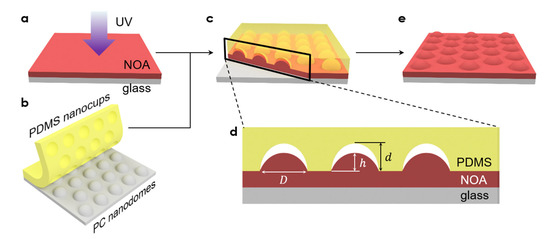
Figure 1.
A schematic description of the curvature-adjustable polymer nanolens fabrication process. (a) Spin-coating of a photopolymer (NOA73) film and its partial UV pre-curing. (b) Replica molding of PDMS nanocups from PC nanodomes. (c) Forming intimate contact between the PDMS nanocup array with the partially cured NOA73 film to induce the nanoscale rise of NOA73 into the nanocup cavities. (d) A cross-sectional snapshot showing underfilled PDMS nanocups. (e) Post-curing and releasing of the PDMS mold reveal the curvature-adjusted nanolens array.
As shown in the cross-sectional view snapshot (Figure 1d), the PDMS nanocups can be underfilled with NOA73. The extent of filling and, hence, the curvature of the nanolens were ultimately determined by the UV dose given to the NOA73 film during the partial pre-curing step. Note that the curvature does not affect the nanolens’ size or vice versa.
As the final step, the NOA73 nanolenses were completely cured by another round of UV exposure. Peeling off the PDMS mold revealed the completed nanolens array (Figure 1e). The nanolens array was then examined with atomic force microscopy (AFM) in the tapping mode, with the height in the center of the nanolens denoted by h (Figure 1d).
2.2. Underlying Mechanism
Figure 2 shows the underlying mechanism of the polymer nanolens formation with UV-adjustable curvature schematically. It is well-known that NOA73 under UV illumination undergoes a so-called “oxygen-inhibition effect” by which its top surface, in direct contact with oxygen, remains fluidic even though it is subject to the highest UV intensity level (Figure 2a) [15]. Owing to the oxygen inhibition effect of the NOA73’s curing process, the thickness of the fluidic layer tL and its viscosity available for adjusting the curvature or height of the nanolens can be precisely determined at a controlled UV dose in the pre-curing step (Figure 1a). Placing the PDMS nanocup mold directly on the fluidic layer (Figure 1c) leads to very intimate contact thanks to the highly soft and deformable nature of PDMS (Figure 2b). The resulting downward vertical force FV will drive the fluidic NOA73 into a lateral flow, followed by an upward displacement (Figure 2c). With judicious control of the viscosity through the UV dose, one can obtain nanolenses with desired curvatures. Such optical control of the nanolens’ curvature, mediated by the UV-induced viscosity modulation, has not been reported to date to the best of the authors’ knowledge.
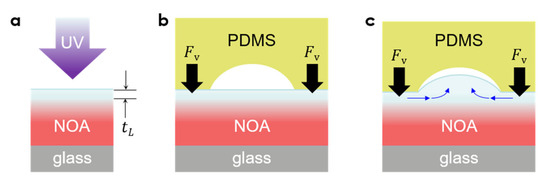
Figure 2.
Underlying mechanism of the curvature-adjustable polymer nanolens formation. (a) The top surface of NOA73 remains fluidic down to tL due to the oxygen inhibition effect. Its viscosity can be controlled through the UV dose. (b) Placing the PDMS mold applies downward forces FV. (c) A judicious control of the viscosity can ensure nanolens formation with the desired curvature.
2.3. Computational Modeling
To further elucidate the physical process of the UV-controlled nanoimprinting, we carried out computational simulations. Figure 3 presents the geometric and finite element mesh models of the PDMS nanocup and NOA73 film. The contact between PDMS and NOA73 was assumed to be frictionless. A uniform pressure was applied on the PDMS nanocup in all simulations and the resulting relative material behaviors and deformations in NOA73 were simulated. To apply uniform pressure to NOA73 and focus only on the imprinting process of NOA73 film, the nonlinearities of the PDMS material were not included in this simulation. Detailed considerations of nonlinear PDMS are left for future studies. All simulations were conducted on ANSYS (release 2022 R2, Canonsburg, PA, USA).
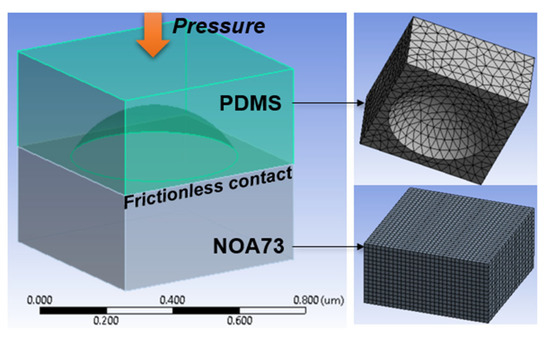
Figure 3.
Geometry and finite element mesh models of the PDMS nanocup cavity and NOA73 film. The interface between them was modeled to be frictionless.
Consistent with our experimental observations [14,16], the UV pre-curing was modeled to decrease the liquidity of NOA73 substantially. Consequently, our simulation showed that pre-cured NOA73 stopped rising at a height inversely proportional to the UV dose, leaving the PDMS nanocup underfilled. This is in contrast to the uncured, liquid-like NOA73 which filled the cavity fully (Appendix A). Thus, NOA73 is modeled as a nonlinear viscoelastic material (Young’s modulus 1600 psi) via the Prony series [17,18] with its relative modulus () and the relation time () subject to fitting.
It is noteworthy that unlike other simulation approaches to UV nanoimprint lithography (e.g., resist filling simulation) [19], this study adopts nonlinear finite element analysis (FEA) due to the relatively low-height, dome-shaped PDMS cavity filling. In simulations, the volume of NOA73 (bottom in Figure 3) is down-pressed to fill the PDMS nanocavity in a viscoelastic manner.
As shown in Figure 3, the NOA73 film carried no pre-specified zone or features that could lead to circular deformation later, whereas PDMS has a circular nanocup geometry. Therefore, the final dome-shaped deformation of the NOA73 film can be solely attributed to the “nanoimprinting.” The results will be presented in detail in Section 3.
With experimental data, the adopted nonlinear FEA requires only two key parameters ( and ) to be calibrated, and the resulting simulation appears reasonable (Section 4) for the purpose of this study. In the future, this study’s approach can be extended to incorporate deeper and more sophisticated approaches such as molecular dynamics simulations [20,21].
3. Results
3.1. Purely UV-Controlled Nanoimprinting Case
The completed nanolenses were examined with AFM in its tapping mode. The results are shown in Figure 4 for four different levels of UV dose. A common color scale was used to emphasize the inverse proportional relationship between the UV dose and h, the final center height of the nanolens.
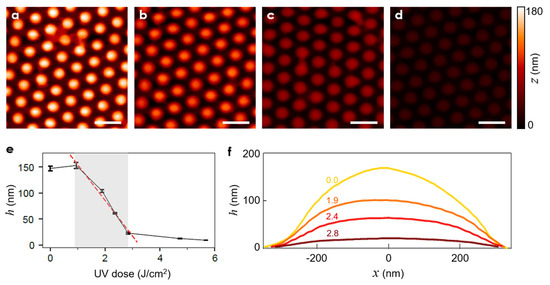
Figure 4.
(a–d) AFM scans of the UV-controlled nanoimprinted nanolenses. The UV doses were: (a) 0.0, (b) 1.9, (c) 2.4, and (d) 2.8 J/cm2 (scale bars: 1.0 μm) (e) The final height h as a function of the UV dose. The bars represent the data range. (f) Cross-sectional profiles of the nanolenses realized with different UV dose levels (specified by the text labels).
Figure 4e shows h over a wider range of UV dose. In particular, within the shaded region, h is an almost linear function of the UV dose, with the slope at approximately −68.8 nm/(J/cm2). At low UV doses, the PDMS nanocups were fully filled with NOA73, leading h eventually to its maximum possible value, i.e., the nanocup depth d. As the UV dose increases, h decreases monolithically, eventually reaching a near-flat value of ~12 nm.
The corresponding profiles of the nanolenses (Figure 4f) clearly reveal how the nanolens’ curvature evolves with the increasing UV dose. As a first-principle analysis, we fitted the nanolens’ curvature profiles to circles. The resulting radii of curvature R turned out to be 343, 548, 817, and 2813 nm. For D = 500 nm, the corresponding f-numbers, defined as
were 1.2, 2.0, 2.9, and 10.0, respectively, with the refractive index n of NOA73 set to 1.56. The results are summarized in Table 1. In Appendix B, we show that even minute changes in the curvature affected the nanolens’ optical functionality significantly.
f/# ≡ f/D ≡ R/(n − 1)/D,

Table 1.
Major structural and optical characteristics of the nanolenses with different UV doses.
3.2. Computational Modeling
The results of the computational modeling, described in Section 2.3, are presented in Figure 5. During the simulations, we iteratively adjusted the material characteristics of NOA73 to obtain the highest level of agreement with the experimentally obtained data shown in Figure 4f. In particular, we focused on the three UV dose values in Table 1.
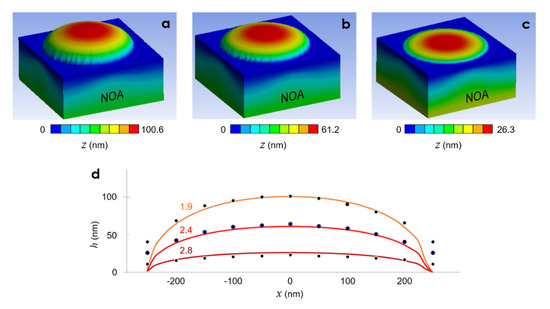
Figure 5.
Best-fitting simulation results: (a–c) bird’s eye view plots of deformed shapes of the three different UV doses in Table 1 (1.9 J/cm2, 2.4 J/cm2, and 2.8 J/cm2), respectively. (d) Simulated cross-sectional profiles of the nanolenses corresponding to the three different UV dose levels (specified by the text labels). The dark dots represent the experimental results shown in Figure 4f.
After convergence is reached, no further deformation of the UV pre-cured NOA73 was observed. Therefore, the final deformation could safely be considered as the result of the nanoimprinting by the PDMS nanocup pressing down on NOA73. It will later be shown in Section 4 that such stabilization occurred in a matter of seconds, corroborating our experimental observations presented in Appendix C.
Figure 5a–c computationally reproduced the experimentally observed inverse proportionality between the UV dose and the nanolens’ height h. For a more detailed comparison between the experimental and simulation results, the center-line profiles of the three nanolenses were scanned and plotted in Figure 5d in superposition with the experimental values. Except for the areas corresponding to the PDMS nanocup’s rim, the two results exhibit good agreement, further corroborating the validity of our computational model.
The discrepancies in the rim area could be ascribed to two factors. First, the AFM scan results often become dubious at corner areas due to the finite width of the AFM probe. Second, the liquid transport near the edge protrusion often involves advection in addition to the typical shear flow [22]. Often, the edge makes the liquid’s interaction with the sidewall more complex [23]. These complications may have led to the discrepancies. As shown in Appendix B, most optical nanolens effects are governed most strongly by the center portion, which lowers the level of attention to be paid to the rim area.
Table 2 summarizes the heights of the nanolenses obtained at the three UV doses, both from the experimental and the best-fitting simulation results. The discrepancy was < 5% in the two low UV dose cases. At the higher UV dose of 2.8 J/cm2, it increased to 16% but the overall agreement in Figure 5d still seems acceptable.

Table 2.
Comparison of the experimental and the best-fitting simulation results.
4. Discussion
The main parameter, or the material characteristic, that we adjusted to match the simulation results to the experimental ones in Figure 4 was the shear modulus of the partially pre-cured NOA73. To incorporate the dynamic, time-varying nature of the shear modulus into the simulation, we adopted the Prony series model in which the shear stiffness is given as a temporal function as follows [17,18]:
where and stand for the relative moduli and the relation time, respectively, for the i-th term. The series can have up to terms. is the initial shear stiffness. In this work, we adopted a single-term Prony series () for gleaning insights into the qualitative behavior of the partially pre-cured NOA73.
Some of the modeling results, which produced the best-fitting results in Figure 5, are shown in Figure 6. The vertical axis of Figure 6a–c represents the shear modulus of NOA73 normalized to the initial elastic shear modulus. From a mechanical perspective, this nanoimprinting experiment corresponds to the “creep” behavior where constant pressure (stress) leads to a gradual nonlinear increase in deformation (strain). In Figure 6, physically implies how much shear stress is relaxed after the creep-induced deformation is over. Consequently, a higher UV dose appears to be linked to a smaller . Furthermore, physically means the ratio of viscosity to stiffness in a typical spring-dashpot representation of viscoelastic material models. Thus, a higher UV dose appears to be linked to a higher (i.e., a higher viscosity).

Figure 6.
(a–c) Prony series models for the three UV doses in Table 1 (1.9 J/cm2, 2.4 J/cm2, and 2.8 J/cm2), respectively.
5. Conclusions
In this paper, we reported a new nanoimprinting technique for realizing nanoscale polymer lenses. The technique allowed us to control the height and curvature of the nanolens through the UV dose given to the polymeric base material (NOA73) during the pre-curing stage without affecting other structural parameters such as the nanolens’ diameter. In our work, by adjusting the UV dose between 1 to 3 J/cm2, we could modulate the final height of the nanolens from ~22 to ~150 nm while maintaining the diameter fixed at 500 nm. The curvature of the nanolens was also modulated, producing f/# values ranging from 1.2 to 10. To elucidate the underlying physical mechanism behind the curvature-control, we carried out numerical simulations. The resulting model, which produced good agreement with the experimental results, suggests that the shear modulus of the partially pre-cured NOA73 undergoes a temporal change with the characteristic time in the range of seconds. The overall behavior of NOA73 predicted from the computational model agrees well with physical intuition. Future work includes refinement of the computational model with higher-order viscoelasticity, nonlinear properties of PDMS, and incorporation of air trapping and compression on the theory side and hybridization with replica molding-induced triboelectric charge [16,24,25,26] on the experimental side.
Author Contributions
Conceptualization, J.K. and I.H.C.; methodology, Q.L.; software, A.C. and I.H.C.; validation, I.H.C. and J.K.; formal analysis, J.K. and M.G.J.; data curation, Q.L and M.G.J.; writing—original draft preparation, J.K.; writing—review and editing, J.K. and I.H.C.; visualization, J.K. and I.H.C.; supervision, J.K.; project administration, J.K. and I.H.C.; funding acquisition, J.K. and I.H.C. All authors have read and agreed to the published version of the manuscript.
Funding
This research was funded by National Science Foundation, grant number CMMI-2129796. M.G.J. was supported by the Catron Fellowship from Iowa State University in part.
Data Availability Statement
All experimental data are available upon request to the corresponding author.
Conflicts of Interest
The authors declare no conflict of interest.
Appendix A
To confirm whether the liquid-like uncured NOA73 can rise to the full height of the nanocup, we performed a fluid dynamic analysis (Figure A1). Without the UV pre-curing process, NOA73 is modeled with typical properties, i.e., viscosity = 130 cps, Young’s modulus = 11.03 MPa, and density = 1200 kg/m3. Through the sides, an influx of NOA73 is allowed while the top side of the nanocup allows air to exit via outlet boundary conditions as NOA73 rises. In this simulation, NOA73 occupies the nanocup almost instantly, less than 1 ms.

Figure A1.
Fluid dynamic simulation results of uncured NOA73: (a) initial stage of uncured NOA73 film and typical air in nanocup; (b) a mid-time step when NOA73 continues rising, air exits through top outlet boundary; and (c) NOA73 fully occupies the nanocup.
Appendix B
To describe the impact of the nanolens’ curvature on its optical functionality, we carried out numerical simulations of wave propagation using a 2D scalar beam propagation method (BPM). The incident wave’s wavelength was set to 400 nm. The spatial resolutions in the longitudinal and transversal directions were commonly set to 10 nm. Transparent boundary conditions were implemented along the top and bottom borders to suppress spurious reflections.
The results for nanolenses fabricated with the UV dose at 0.0 and 1.9 J/cm2 are shown in Figure A2a,b, respectively. They reveal that the seemingly small curvature and height changes (see Table 1) can incur significant variations in their near- and far-field patterns. The nanolens in Figure A2a turned out to form a very strong sub-diffraction concentration of light which is known to produce a variety of super-focusing and magnification effects [1]. On the other hand, the one on Figure A2b, with a flatter curvature, focused the wave less tightly in its near-field but produced a slower transfer of the wave power to the sidelobes, maintaining higher power in the axial center in the far-field. More interesting, and potentially useful, variations may be found through further studies.
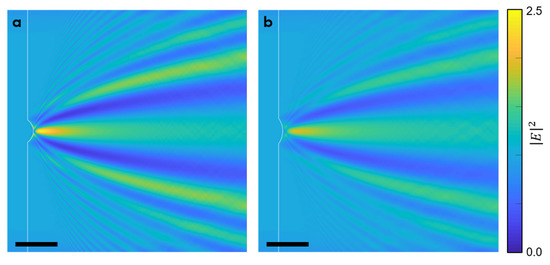
Figure A2.
BPM simulation results of plane wave focusing caused by nanolenses fabricated with a UV dose of (a) 0.0 J/cm2 and (b) 1.9 J/cm2. The output patterns are distinctly different in their near- and far-field characteristics (scale bars: 1 μm).
Appendix C
Some may argue that the UV dose-mediated control of the nanolens’ final height and curvature is the consequence of not giving sufficient time for NOA73 to complete its deformation at the stage of contact nanoimprinting (Figure 1c). To make sure that this is not the case, we allowed extra-long contact time and monitored the evolution of the curvature. Figure A3 shows the profiles scanned from nanolenses imprinted with three different contact time periods: 1, 5, and 40 min. Within the scan range, the average h values turned out to be 20.2, 23.3, and 19.5 nm, respectively. The results suggest that 1 min, which we have typically adopted throughout our experiments, is sufficient time for the nanolens to reach the final h. Allowing a longer contact time did not bring meaningful changes.
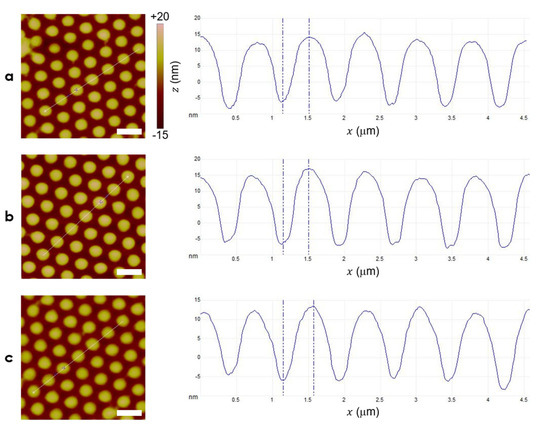
Figure A3.
AFM scans of the nanolenses fabricated with different contact times: (a) 1.0, (b) 5.0, and (c) 40 min. The insets on the right show the profiles along the white scan lines.
References
- Lee, J.Y.; Hong, B.H.; Kim, W.Y.; Min, S.K.; Kim, Y.; Jouravlev, M.V.; Bose, R.; Kim, K.S.; Hwang, I.C.; Kaufman, L.J.; et al. Near-Field Focusing and Magnification through Self-Assembled Nanoscale Spherical Lenses. Nature 2009, 460, 498–501. [Google Scholar] [CrossRef]
- Dyett, B.; Zhang, Q.; Xu, Q.; Wang, X.; Zhang, X. Extraordinary Focusing Effect of Surface Nanolenses in Total Internal Reflection Mode. ACS Cent. Sci. 2018, 4, 1511–1519. [Google Scholar] [CrossRef] [PubMed]
- Chen, Y.; Elshobaki, M.; Ye, Z.; Park, J.M.; Noack, M.A.; Ho, K.M.; Chaudhary, S. Microlens Array Induced Light Absorption Enhancement in Polymer Solar Cells. Phys. Chem. Chem. Phys. 2013, 15, 4297–4302. [Google Scholar] [CrossRef] [PubMed]
- Morozov, S.; Gaio, M.; Maier, S.A.; Sapienza, R. Metal-Dielectric Parabolic Antenna for Directing Single Photons. Nano Lett. 2018, 18, 3060–3065. [Google Scholar] [CrossRef] [PubMed]
- Carstensen, M.S.; Zhu, X.; Iyore, O.E.; Mortensen, N.A.; Levy, U.; Kristensen, A. Holographic Resonant Laser Printing of Metasurfaces Using Plasmonic Template. ACS Photonics 2018, 5, 1665–1670. [Google Scholar] [CrossRef]
- Verma, A.; Sharma, A. Enhanced Self-Organized Dewetting of Ultrathin Polymer Films under Water-Organic Solutions: Fabrication of Sub-Micrometer Spherical Lens Arrays. Adv. Mater. 2010, 22, 5306–5309. [Google Scholar] [CrossRef][Green Version]
- Vlad, A.; Huynen, I.; Melinte, S. Wavelength-Scale Lens Microscopy via Thermal Reshaping of Colloidal Particles. Nanotechnology 2012, 23, 285708. [Google Scholar] [CrossRef]
- Kang, D.; Pang, C.; Kim, S.M.; Cho, H.S.; Um, H.S.; Choi, Y.W.; Suh, K.Y. Shape-Controllable Microlens Arrays via Direct Transfer of Photocurable Polymer Droplets. Adv. Mater. 2012, 24, 1709–1715. [Google Scholar] [CrossRef]
- Bao, L.; Rezk, A.R.; Yeo, L.Y.; Zhang, X. Highly Ordered Arrays of Femtoliter Surface Droplets. Small 2015, 11, 4850–4855. [Google Scholar] [CrossRef]
- McAlpine, M.C.; Friedman, R.S.; Lieber, C.M. Nanoimprint Lithography for Hybrid Plastic Electronics. Nano Lett. 2003, 3, 443–445. [Google Scholar] [CrossRef]
- Zhu, X.; Czolkos, I.; Johansson, A.; Nielsen, T.; Kristensen, A. Master Origination by 248 Nm DUV Lithography for Plasmonic Color Generation. Appl. Phys. Lett. 2021, 118, 141103. [Google Scholar] [CrossRef]
- Kreuzer, M.; Whitworth, G.L.; Francone, A.; Gomis-Bresco, J.; Kehagias, N.; Sotomayor-Torres, C.M. In-Line Metrology for Roll-to-Roll UV Assisted Nanoimprint Lithography Using Diffractometry. APL Mater. 2018, 6, 058502. [Google Scholar] [CrossRef]
- Dutta, R.K.; van Kan, J.A.; Bettiol, A.A.; Watt, F. Polymer Microlens Replication by Nanoimprint Lithography Using Proton Beam Fabricated Ni Stamp. Nucl. Instrum. Methods Phys. Res. B 2007, 260, 464–467. [Google Scholar] [CrossRef]
- Li, Q.; Ji, M.G.; Kim, J. Grayscale Nanopixel Printing at Sub-10-Nanometer Vertical Resolution via Light-Controlled Nanocapillarity. ACS Nano 2020, 14, 6058–6066. [Google Scholar] [CrossRef] [PubMed]
- Lee, T.Y.; Guymon, C.A.; Jönsson, E.S.; Hoyle, C.E. The Effect of Monomer Structure on Oxygen Inhibition of (Meth)Acrylates Photopolymerization. Polymer 2004, 45, 6155–6162. [Google Scholar] [CrossRef]
- Li, Q.; Peer, A.; Cho, I.H.; Biswas, R.; Kim, J. Replica Molding-Based Nanopatterning of Tribocharge on Elastomer with Application to Electrohydrodynamic Nanolithography. Nat. Commun. 2018, 9, 974. [Google Scholar] [CrossRef]
- Siacor, F.D.C.; Chen, Q.; Zhao, J.Y.; Han, L.; Valino, A.D.; Taboada, E.B.; Caldona, E.B.; Advincula, R.C. On the Additive Manufacturing (3D Printing) of Viscoelastic Materials and Flow Behavior: From Composites to Food Manufacturing. Addit. Manuf. 2021, 45, 102043. [Google Scholar] [CrossRef]
- Chen, T. Determining a Prony Series for a Viscoelastic Material from Time Varying Strain Data; TM-2000-210123; NASA Langley Technical Report Server: Washington, DC, USA, 2000. [Google Scholar]
- Yin, M.; Sun, H.; Wang, H. Resist Filling Study for UV Nanoimprint Lithography Using Stamps with Various Micro/Nano Ratios. Micromachines 2018, 9, 335. [Google Scholar] [CrossRef]
- Uchida, H.; Imoto, R.; Ando, T.; Okabe, T.; Taniguchi, J. Molecular Dynamics Simulation of the Resist Filling Process in UV-Nanoimprint Lithography. J. Photopolym. Sci. Tech. 2021, 34, 139–144. [Google Scholar] [CrossRef]
- Iwata, J.; Ando, T. Molecular Dynamics Study on Behavior of Resist Molecules in UV-Nanoimprint Lithography Filling Process. Nanomaterials 2022, 12, 2554. [Google Scholar] [CrossRef]
- Mendels, D.A. Multi-Scale Modelling of Nano-Imprint Lithography. Emerg. Lithogr. Technol. X 2006, 6151, 615113. [Google Scholar] [CrossRef]
- Teyssèdre, H.; Gilormini, P.; Régnier, G. Limitations of Simple Flow Models for the Simulation of Nanoimprint. Int. Polym. Process. 2013, 1, 72–78. [Google Scholar] [CrossRef]
- Li, Q.; Cho, I.H.; Biswas, R.; Kim, J. Nanoscale Modulation of Friction and Triboelectrification via Surface Nanotexturing. Nano Lett. 2019, 19, 850–856. [Google Scholar] [CrossRef] [PubMed]
- Ji, M.G.; Li, Q.; Biswas, R.; Kim, J. Stability and Temporal Decay of Nanopatterned Tribocharge on Nanotextured Elastomer Surfaces. Nano Energy 2021, 79, 105441. [Google Scholar] [CrossRef]
- Ji, M.G.; Bazroun, M.; Cho, I.H.; Slafer, W.D.; Biswas, R.; Kim, J. Mechano-Triboelectric Analysis of Surface Charge Generation on Replica-Molded Elastomeric Nanodomes. Micromachines 2021, 12, 1460. [Google Scholar] [CrossRef]
Publisher’s Note: MDPI stays neutral with regard to jurisdictional claims in published maps and institutional affiliations. |
© 2022 by the authors. Licensee MDPI, Basel, Switzerland. This article is an open access article distributed under the terms and conditions of the Creative Commons Attribution (CC BY) license (https://creativecommons.org/licenses/by/4.0/).